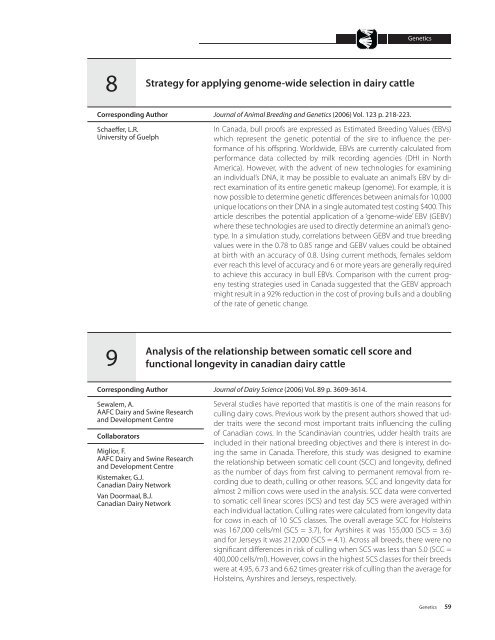A52-75-2007E.pdf - AgroMedia International Inc
A52-75-2007E.pdf - AgroMedia International Inc
A52-75-2007E.pdf - AgroMedia International Inc
Create successful ePaper yourself
Turn your PDF publications into a flip-book with our unique Google optimized e-Paper software.
Genetics8Strategy for applying genome-wide selection in dairy cattleCorresponding AuthorSchaeffer, L.R.University of GuelphJournal of Animal Breeding and Genetics (2006) Vol. 123 p. 218-223.In Canada, bull proofs are expressed as Estimated Breeding Values (EBVs)which represent the genetic potential of the sire to influence the performanceof his offspring. Worldwide, EBVs are currently calculated fromperformance data collected by milk recording agencies (DHI in NorthAmerica). However, with the advent of new technologies for examiningan individual’s DNA, it may be possible to evaluate an animal’s EBV by directexamination of its entire genetic makeup (genome). For example, it isnow possible to determine genetic differences between animals for 10,000unique locations on their DNA in a single automated test costing $400. Thisarticle describes the potential application of a ‘genome-wide’ EBV (GEBV)where these technologies are used to directly determine an animal’s genotype.In a simulation study, correlations between GEBV and true breedingvalues were in the 0.78 to 0.85 range and GEBV values could be obtainedat birth with an accuracy of 0.8. Using current methods, females seldomever reach this level of accuracy and 6 or more years are generally requiredto achieve this accuracy in bull EBVs. Comparison with the current progenytesting strategies used in Canada suggested that the GEBV approachmight result in a 92% reduction in the cost of proving bulls and a doublingof the rate of genetic change.9Analysis of the relationship between somatic cell score andfunctional longevity in canadian dairy cattleCorresponding AuthorSewalem, A.AAFC Dairy and Swine Researchand Development CentreCollaboratorsMiglior, F.AAFC Dairy and Swine Researchand Development CentreKistemaker, G.J.Canadian Dairy NetworkVan Doormaal, B.J.Canadian Dairy NetworkJournal of Dairy Science (2006) Vol. 89 p. 3609-3614.Several studies have reported that mastitis is one of the main reasons forculling dairy cows. Previous work by the present authors showed that uddertraits were the second most important traits influencing the cullingof Canadian cows. In the Scandinavian countries, udder health traits areincluded in their national breeding objectives and there is interest in doingthe same in Canada. Therefore, this study was designed to examinethe relationship between somatic cell count (SCC) and longevity, definedas the number of days from first calving to permanent removal from recordingdue to death, culling or other reasons. SCC and longevity data foralmost 2 million cows were used in the analysis. SCC data were convertedto somatic cell linear scores (SCS) and test day SCS were averaged withineach individual lactation. Culling rates were calculated from longevity datafor cows in each of 10 SCS classes. The overall average SCC for Holsteinswas 167,000 cells/ml (SCS = 3.7), for Ayrshires it was 155,000 (SCS = 3.6)and for Jerseys it was 212,000 (SCS = 4.1). Across all breeds, there were nosignificant differences in risk of culling when SCS was less than 5.0 (SCC =400,000 cells/ml). However, cows in the highest SCS classes for their breedswere at 4.95, 6.73 and 6.62 times greater risk of culling than the average forHolsteins, Ayrshires and Jerseys, respectively.Genetics 59





